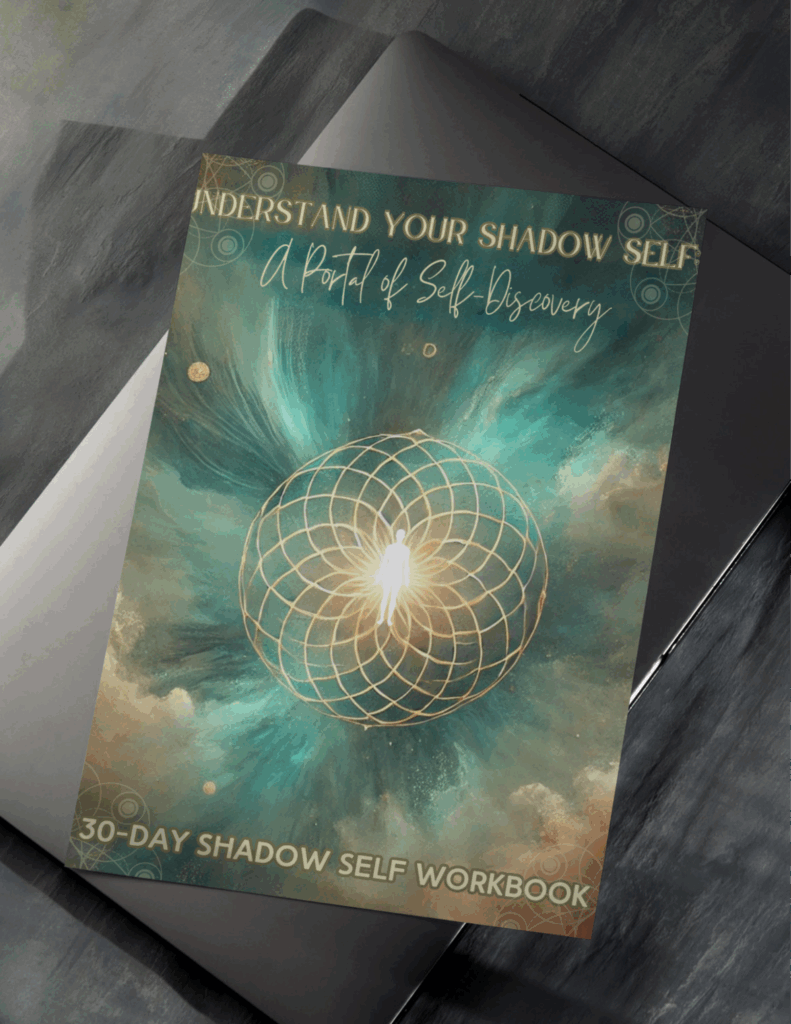Ever notice how certain people or situations trigger something deep within you and you’re not sure why? That’s your shadow self calling. And when you learn to work with it, not against it, life gets lighter, clearer, and far more empowered.
Shadow work is the process of exploring and integrating the hidden parts of ourselves ~ the parts we’ve denied, suppressed, or rejected. These “shadows” are not bad; they’re simply unacknowledged. And the more we bring them to light, the more whole we become.
“Until you make the unconscious conscious, it will direct your life and you will call it fate.” – Carl Jung
In this post, we’ll explore 5 powerful types of shadow work that can help you reclaim your truth, deepen your emotional freedom, and embody your most authentic self.
Please move through this process with ease and grace.
Shadow work can stir deep emotions, and it’s completely normal to feel discomfort. If any exercise feels too intense, pause. Give yourself space. There is no right or wrong way to do this. Release any judgment about how it “should” look or feel. Trust your timing, trust your process and most of all, trust yourself. You’re doing it exactly right.
Let’s begin.
1. Inner Child Work
Your inner child is the part of you that still holds your earliest experiences, emotions, and unmet needs.
When that part is ignored or suppressed, it can quietly influence your adult life, leading to people-pleasing, fear of rejection, or chronic self-doubt.
Tending to your inner child is not about staying stuck in the past. It’s about offering your younger self what they never received, so you can move forward feeling whole, empowered, and free.
Signs Your Inner Child May Need Attention:
👂 You feel overly sensitive to criticism
🚫 You struggle to set or hold healthy boundaries
💔 You crave external validation to feel worthy
😔 You experience intense guilt, shame, or fear after asserting yourself
Try This Gentle Practice:
📝 Write a letter to your younger self
- Speak to them like you would a child you deeply love.
- Acknowledge their pain and innocence.
- Say the words they always needed to hear.
💗 Examples:
- “I’m so proud of you.”
- “You were never too much.”
- “You deserved to feel safe and loved.”
💡 Look at a childhood photo while journaling. Let your heart soften. This visual connection can unlock deeper healing and emotional release.
“Healing your inner child is not about changing the past ~ it’s about giving yourself what you needed then, now.”

2. Mirror Work
Mirror work is one of the most direct and disarming ways to meet your shadow.
It reveals the internal dialogue you’ve been carrying, often unconsciously, and helps you begin rewriting that narrative with truth and compassion.
When we avoid our own reflection, we’re often avoiding the deeper emotional truths it holds. But when we lean in, eye to eye, we open a portal to healing the parts of us that feel unworthy, unseen, or unloved.
How to Practice Mirror Work:
🪞 Step 1: Stand in front of a mirror in a quiet space, ideally in natural light.
🪞 Step 2: Soften your gaze and look into your own eyes for 1–2 minutes. Resist the urge to look away.
🪞 Step 3: Gently speak affirmations aloud. Try:
- “I see you.”
- “I love you.”
- “You are enough exactly as you are.”
- “It’s safe to be fully seen.”
Let any emotions rise ~ tears, discomfort, even laughter. This is your shadow being witnessed.
💬 If affirmations feel hard at first, start by simply naming what you see without judgment. Over time, the mirror becomes a sacred space of reflection, not rejection.
“Your reflection is a portal to self-love, if you dare to see beyond the surface.”
3. Shadow Work Journal Prompts
Every trigger holds wisdom, if you’re willing to listen. It’s not just about what happened, it’s about what’s unhealed underneath.
Start here:
- When something activates you emotionally, pause.
- Ask: What emotion am I experiencing? When have I felt this before?
- Journal what rises, without censoring, fixing, or analyzing.
- Notice recurring themes, language, or sensations in your body.
Your shadow is revealed in the stories you tell yourself when you’re hurting.
🖊️ Ready to go deeper?
Download my full 30-day workbook,
“Understand Your Shadow Self: A Portal of Self-Discovery”
and receive powerful prompts, deep reflections, and soul-shifting exercises to transform your emotional patterns and reconnect with your truth.
4. Archetype Exploration
Archetypes are the inner characters and energies that shape our thoughts, behaviors, and beliefs. They can be powerful guides or unconscious saboteurs depending on how we relate to them.
Some, like the Healer, Teacher, or Inner Child, feel empowering and familiar.
Others like the Victim, Saboteur, Addict, or People Pleaser often dwell in the shadow, operating behind the scenes of our reactions and decisions.
But here’s the truth: even our shadow archetypes are trying to help us. They’re just working with outdated programming or unhealed pain.
Try this:
🎭 Step 1: Brainstorm shadow archetypes that resonate. Victim, Inner Critic, Rebel, Martyr, Perfectionist, etc.
✍️ Step 2: Choose one and journal:
How does this archetype show up in my thoughts, behaviors, or patterns?
What might it be trying to teach me or protect me from?
What unmet need does this archetype carry?
How can I meet that need in a healthier way today?
💡 Tip: Use meditation or visualization to “meet” this archetype. Invite it into a conversation. Ask questions. Soften judgment. You’re not here to exile it, you’re here to understand it.
“The parts of us we judge the most are usually the ones that once kept us safe.”
5. Somatic Shadow Work
Not all shadows live in the mind, some live in the tissues, muscles, and nervous system.
When emotions aren’t fully expressed or processed, they don’t just disappear, they get stored in the body as tension, patterns, and physical sensations.
Somatic shadow work helps us access what words alone can’t reach. It reconnects us with our body’s innate wisdom, helping us safely feel and release what’s been buried beneath the surface.
Somatic shadow work includes:
Breathwork
Embodiment practices
Trauma-informed movement
Example:
During breathwork, many people experience emotional releases like tears, shaking, or deep laughter are signs that stored emotions are moving out.
🔥This is a guided somatic exercise that I use all the time.
How to Start Shadow Work
Shadow work can be deep, tender, and transformational. So it’s essential to:
Create a safe container (time, space, and privacy)
Ground yourself before and after (breath, nature, water)
Start small and go slow
Work with a guide or mentor when needed
“You are not broken. You’re unfolding.”
The goal is not to fix yourself, but to meet yourself with honesty and love.
Final Thoughts: Your Shadows Are Your Superpower
The parts you’ve hidden aren’t holding you back—they’re waiting to be heard.
Shadow work is an invitation to come home to yourself, to reclaim your full expression, and to rise—not in spite of your shadows, but because of them.
You are whole. And every shadow holds a gift.
Ready to go deeper?
Download my free “Beginners Guide To Shadow Work” and begin your journey of healing, clarity, and self-reclamation today.
If this sparked something within you, pass it on. Someone else is ready to expand too.
The path of expansion never ends ~ and neither do your possibilities.
With love, Limitless With Laura | The Expansion Code










